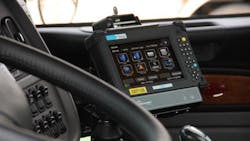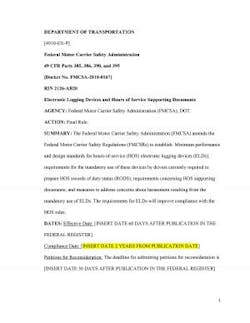The Federal Motor Carrier Safety Administration (FMCSA) is trying once again to craft a legally-sustainable electronic logging device (ELD) rule after several failed attempts in the past. The agency formally rolled out its long-awaited final rule mandating the use of ELD by commercial motor vehicle operators to record hours-of-service (HOS) data.
“Since 1938, complex, on-duty/off-duty logs for truck and bus drivers were made with pencil and paper, virtually impossible to verify,” noted U.S. Transportation Secretary Anthony Foxx in a statement. “This automated technology [ELDs] not only brings logging records into the modern age, it also allows roadside safety inspectors to unmask violations of federal law that put lives at risk.”
The rule will take effect in two years, but if a carrier installs a compliant advanced onboard recording device (AONRD) prior to the compliance date, it will have the option to continue using that device for an additional two years beyond the compliance data.
FMCSA said its ELD mandate will result in an annual net benefit of more than $1 billion – largely by reducing paperwork – and will also increase the efficiency of roadside law enforcement personnel in reviewing the driver records.
The agency added that, on an annual average basis, use of ELDs should help save 26 lives and prevent 1,844 crashes involving large commercial motor vehicles annually.
FMCSA noted several key elements and impacts from its ELD final rule:
- It establishes a two-year compliance window for commercial truck and bus drivers to adopt ELDs.
- The agency anticipates that approximately three million commercial vehicle drivers will be impacted by the ELD mandate.
- The ELD rule strictly prohibits driver harassment by providing both procedural and technical provisions to prevent harassment resulting from ELD-generated information.
- A separate FMCSA rulemaking further safeguards drivers from being coerced to violate HOS regulations, providing the agency with the authority to take enforcement actions not only against motor carriers, but also against shippers, receivers, and transportation intermediaries.
- The new rule establishes technology specifications detailing performance and design requirements for ELDs so that manufacturers are able to produce compliant devices and systems.
Click here for more stories and information on the ELD rule.
New HOS supporting document rules within the ELD mandate will help reduce paperwork needs, such as the retention of shipping documents, fuel purchase receipts, etc. In most cases, a motor carrier using ELDs will not be required to retain supporting documents verifying on-duty driving time, FMCSA said.
The ELD final rule permits the use of smartphones and other wireless devices as ELDs, so long as they satisfy technical specifications and are certified. Canadian- and Mexican-domiciled drivers will also be required to use ELDs when operating on U.S. roadways.
Motor carriers that have previously installed compliant automatic onboard recording devices may continue to use the devices for an additional two years beyond the compliance date.
Following publication of the proposed rule back in early 2014, several suppliers of ELDs said the flexibility afford by the rule would lead to innovation and help control costs for fleets.
The rule will require ELDs for all commercial motor vehicle operations that fall under 49 CFR part 395 and for situations where the driver is required to complete a record of duty status (RODS) under 49 CFR 395.8.
Drivers who are exempt from the ELD requirement includes those who use paper RODS for not more than eight days in any 30-day period; those who conduct driveaway-towaway operations where the vehicle being driven is the commodity being delivered; and those of vehicles that were manufactured before model-year 2000.
The rule covers data transfer technologies and requires either a display or printout for backup as a means to access necessary enforcement data. Data can be transferred via a wireless web service and email or through Bluetooth and USB 2.0.
In its cost analysis, FMCSA determined the addition of a printer would increase ELD costs about 40%.
Carriers must retain up to eight supporting documents for every 24-hour period a driver using ELDs is on duty. Those documents must be retained for six months, and drivers must submit supporting documents to the motor carrier no later than 13 days after receiving them.
Those supporting documents must include:
Driver name or carrier-assigned identification number, either on the document or on another document enabling the carrier to link the document to the driver, or the vehicle unit number if that number can be 14 linked to the driver;
- Date;
- Location (including name of nearest city, town, or village); and
- Time.
Supporting documents may come from the following five categories:
- Bills of lading, itineraries, schedules, or equivalent documents that indicate the origin and destination of each trip;
- Dispatch records, trip records, or equivalent documents;
- Expense receipts;
- Electronic mobile communication records, reflecting communications transmitted through a fleet management system (FMS); and
- Payroll records, settlement sheets, or equivalent documents that indicates payment to a driver.
This is not FMCSA’s first attempt at electronic logs. The supplemental notice of proposed rulemaking back in 2014 tried to dance around concerns over harassment and supporting documents. Those two issues were subjects of litigation, and the harassment issue ultimately scuttled FMCSA’s prior electronic log rule, which was adopted in April 2010.
The agency has tried to address the harassment concern with another rulemaking just announced covering coercion. That rule, set to take effect on Jan. 29, addresses three key areas: procedures for commercial truck and bus drivers to report incidents of coercion to the FMCSA, steps the agency could take when responding to such allegations, and penalties that may be imposed on entities found to have coerced drivers.
“The design of the ELD allows only limited edits of an ELD record by both the driver and the motor carrier’s agents and in either case the original record generated by the device cannot be changed, which will protect the driver’s RODS from manipulation,” FMCSA wrote in the final rule.

